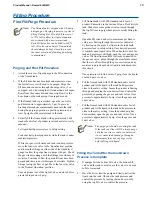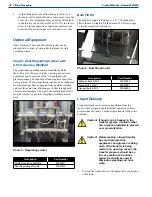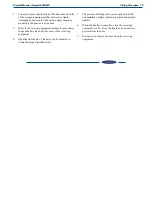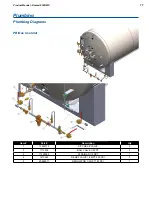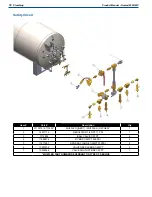
3
Product Manual - Nomad 830G MP
General
Chart equipment is designed and built to the most rigid
standards, however no piece of mechanical equipment can
ever be made 100% foolproof. Strict compliance with proper
safety and handling practices is necessary when using a
cryogenic system. We recommend that all our customers
re-emphasize safety and safe handling practices to all their
employees and customers
While every possible safety feature has been designed into
the unit and safe operations are anticipated, it is essential
that the user of the cryogenic system carefully read and fully
understand all WARNINGS and CAUTION notes listed in
this safety summary and enumerated below.
The Nomad 830 MP, with its stainless steel support system is
designed, manufactured and tested to function normally for
many years of service
Warning! It is never safe to drop a liquid
cylinder or let it fall over in
oxygen or any cryogenic
service.
In the event a liquid cylinder is inadvertently dropped, tipped
over, or abused slowly raise it to its normal vertical position
and immediately open the vent valve to release any excess
pressure in a safe manner. As soon as possible remove the
liquid product from the vessel in a safe manner. If the vessel
has been used in oxygen service, purge it with an inert gas
(nitrogen). If damage is evident or suspected, return the
unit to Chart prominently marked “LIQUID CYLINDER
DROPPED INSPECT FOR DAMAGE ”
Warning! Any welding that is done on the
outside of the 830 MP can cause
loss of vacuum and will VOID
any warranty on the unit.
Warning! Before removing any parts or
loosening fittings, completely
empty the cryogenic cylinder of
liquid contents and release any
vapor pressure in a safe manner.
External valves and fittings can become extremely cold
and may cause painful burns to personnel unless properly
protected. Personnel must wear protective gloves and eye
protection whenever removing parts or loosening fittings.
Failure to do so may result in personal injury due to the
extreme cold and pressure in the cylinder.
Warning! Use only replacement parts
that are compatible with liquid
oxygen and have been cleaned
for oxygen use.
Do not use regulators, fittings, hoses, etc., which have been
previously used in a compressed air environment Failure to
comply with these instructions may result in serious damage
to the container.
Caution! All valves on an empty 830 MP
should always be kept closed
to protect the inner vessel
and plumbing from being
contaminated.
Safety Bulletin
Portions of the following information is extracted from
Safety Bulletin SB-2 from the Compressed Gas Association,
Inc. Additional information on oxygen, nitrogen, argon, and
cryogenics is available from the CGA.
Cryogenic containers, stationary or portable, are from time
to time subjected to assorted environmental conditions of
an unforeseen nature. This safety bulletin is intended to call
attention to the fact that whenever a cryogenic container
is involved in any incident whereby the container or its
safety devices are damaged, good safety practices must be
followed. The same holds true whenever the integrity or
function of a container is suspected of abnormal operation
Incidents which require that such practices be followed
include: highway accidents, immersion of a container in
water, exposure to extreme heat or fire, and exposure to most
adverse weather conditions (earthquake, tornadoes, etc.)
Under no circumstances should a damaged container be left
with product in it for an extended period of time.
Prior to reusing a damaged container, the unit must be
tested, evaluated and repaired as necessary. It is highly
recommended that any damaged container be returned to
Chart for repair and re-certification.
In the event of known or suspected container vacuum
problems (even if an extraordinary circumstance such as
those noted above has not occurred), do not continue to use
the unit. Continued use of a cryogenic container that has a
vacuum problem can lead to embrittlement and cracking.
Safety

















